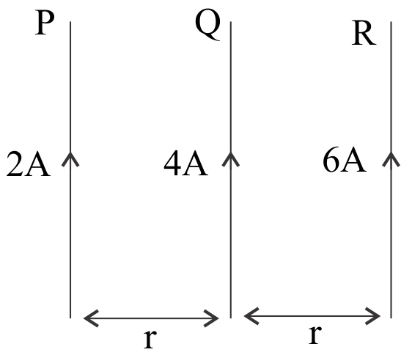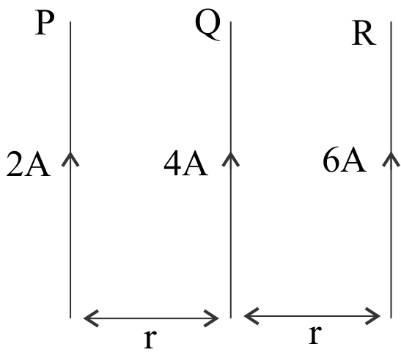
P, Q and R long parallel straight wires in air, carrying currents as shown. The direction of the resultant force on R is

(A) Towards left
(B) Towards right
(C) The same as that of current in Q
(D) Perpendicular to the plane of paper
Answer
219.9k+ views
HintTo answer this question we should have knowledge about the concept of current carrying conductors. Use Fleming's left hand rule to find the direction of the resultant force.
Complete step by step answer
When current passes through a conductor it produces a magnetic field around it. The current flowing through the conductor induces a magnetic field around it. The magnetic field produced by the electric field is known as an induced magnetic field. The direction force on a current carrying conductor is given by Fleming’s left hand rule.
The forefinger middle finger and the thumb finger are held in mutually perpendicular direction if the middle finger points the direction of the current then the fore finger points the direction of magnetic field and the thumb finger points the direction of the force on the current carrying conductor.
If we take two current carrying conductors placed in a short distance r. Then both the current carrying conductors produce their own induced magnetic fields. This induced magnetic field of force affects the direction of force of current.
The two conductors will experience an attractive force towards each other if the both of the current carrying conductors carry current in the same direction due to the induced magnetic field and the two conductors will experience a repulsive force towards each other if both of the current carrying conductors carry current in opposite directions. The resultant force will be towards the direction of attraction if attracted and away from the conductor if repelled.

Here from the diagram we can see,
The conductor Q has a current of $4A$
The conductor P has a current of $2A$
The conductor R has a current of $6A$
We have to find the direction of resultant force on R
From the diagram, between the wire Q, R and P there will be a force of attraction and the resultant force will be towards the left since they carry current in the same direction and according to the Fleming left and rule.
Hence the correct answer is option 1. Towards left.
Note: We can also use the right hand rule to find the direction of the current and magnetic field of a current carrying conductor the right hand rule states that Right hand rule states that if the current carrying conductor is held in the right hand then the thumb finger pointing towards the direction of current flow and the other fingers curled around the conductor then the curled fingers indicate the direction of the magnetic field due to the current carrying conductor.
Complete step by step answer
When current passes through a conductor it produces a magnetic field around it. The current flowing through the conductor induces a magnetic field around it. The magnetic field produced by the electric field is known as an induced magnetic field. The direction force on a current carrying conductor is given by Fleming’s left hand rule.
The forefinger middle finger and the thumb finger are held in mutually perpendicular direction if the middle finger points the direction of the current then the fore finger points the direction of magnetic field and the thumb finger points the direction of the force on the current carrying conductor.
If we take two current carrying conductors placed in a short distance r. Then both the current carrying conductors produce their own induced magnetic fields. This induced magnetic field of force affects the direction of force of current.
The two conductors will experience an attractive force towards each other if the both of the current carrying conductors carry current in the same direction due to the induced magnetic field and the two conductors will experience a repulsive force towards each other if both of the current carrying conductors carry current in opposite directions. The resultant force will be towards the direction of attraction if attracted and away from the conductor if repelled.

Here from the diagram we can see,
The conductor Q has a current of $4A$
The conductor P has a current of $2A$
The conductor R has a current of $6A$
We have to find the direction of resultant force on R
From the diagram, between the wire Q, R and P there will be a force of attraction and the resultant force will be towards the left since they carry current in the same direction and according to the Fleming left and rule.
Hence the correct answer is option 1. Towards left.
Note: We can also use the right hand rule to find the direction of the current and magnetic field of a current carrying conductor the right hand rule states that Right hand rule states that if the current carrying conductor is held in the right hand then the thumb finger pointing towards the direction of current flow and the other fingers curled around the conductor then the curled fingers indicate the direction of the magnetic field due to the current carrying conductor.
Recently Updated Pages
Electricity and Magnetism Explained: Key Concepts & Applications

JEE Energetics Important Concepts and Tips for Exam Preparation

JEE Isolation, Preparation and Properties of Non-metals Important Concepts and Tips for Exam Preparation

JEE Main 2021 July 25 Shift 1 Question Paper with Answer Key

JEE Main 2021 July 22 Shift 2 Question Paper with Answer Key

States of Matter Chapter For JEE Main Chemistry

Trending doubts
JEE Main 2026: Application Form Open, Exam Dates, Syllabus, Eligibility & Question Papers

Understanding Uniform Acceleration in Physics

Derivation of Equation of Trajectory Explained for Students

Hybridisation in Chemistry – Concept, Types & Applications

Understanding the Angle of Deviation in a Prism

Understanding Atomic Structure for Beginners

Other Pages
JEE Advanced Marks vs Ranks 2025: Understanding Category-wise Qualifying Marks and Previous Year Cut-offs

Dual Nature of Radiation and Matter Class 12 Physics Chapter 11 CBSE Notes - 2025-26

How to Convert a Galvanometer into an Ammeter or Voltmeter

Understanding Centrifugal Force in Physics

JEE Main Marking Scheme 2026- Paper-Wise Marks Distribution and Negative Marking Details

Degree of Dissociation: Meaning, Formula, Calculation & Uses




